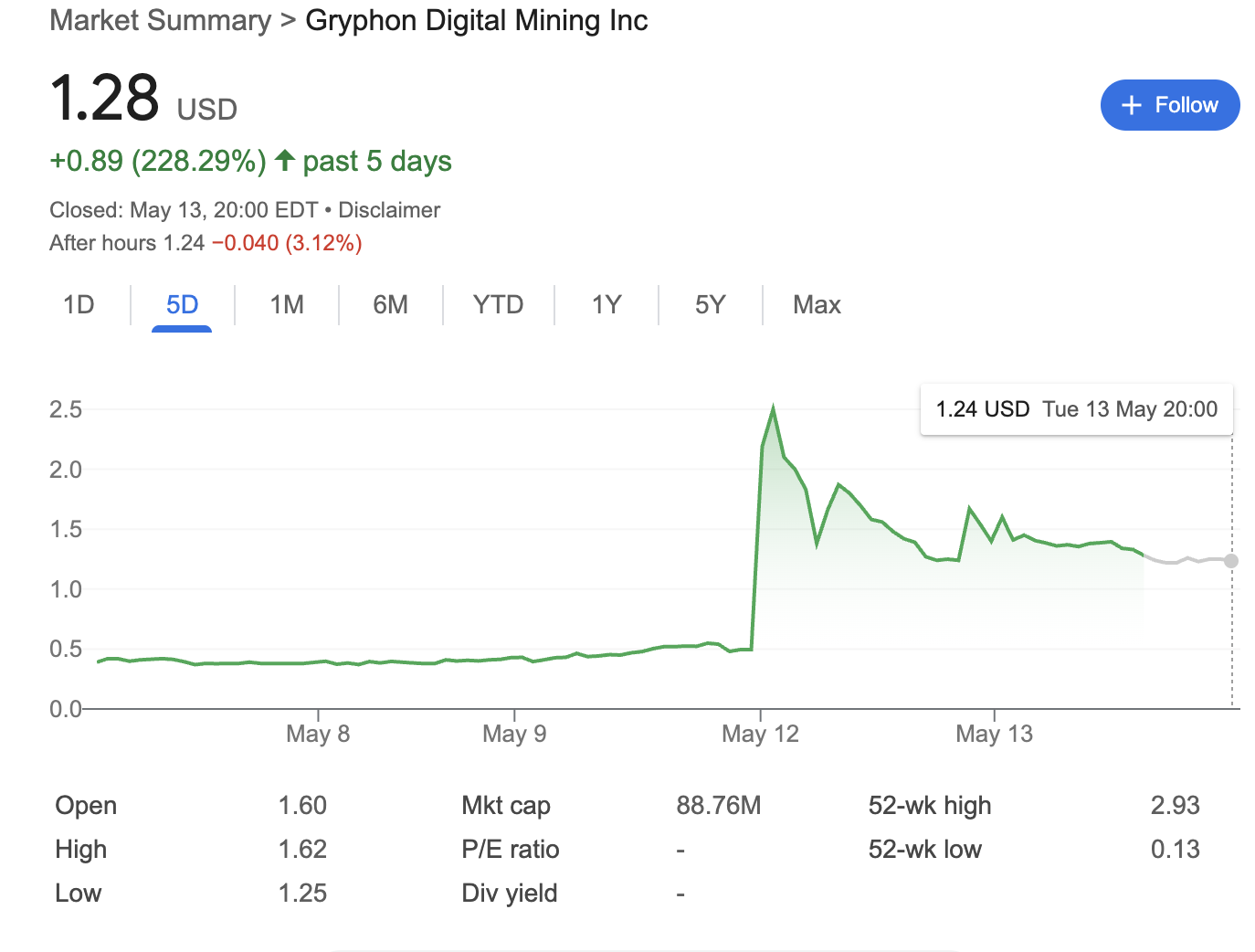Source: Cointelegraph
Original: “Trump Family Gets Involved in Bitcoin (BTC) Mining! Stock Surge Following IPO News, How Do Industry Changes Drive Bitcoin Price Fluctuations?”
Eric Trump, son of Donald Trump, supports a Bitcoin mining company that announced on Monday (May 12) plans to go public this year, further deepening the Trump family's involvement in the cryptocurrency space.
The company, named American Bitcoin, will go public on the Nasdaq through a merger with the already listed Gryphon Digital Mining, with the transaction expected to be completed in the third quarter of this year.
Following this news, Gryphon Digital Mining's stock price soared over 171% on Monday, with a 5-day increase of 228.29%.

Gryphon Digital Mining's stock price trend over the past five days. Source: Google Finance
According to the company profile released on Monday, its goal is to mine new Bitcoin (BTC) “at a cost below market rates” and accumulate Bitcoin reserves, stating, “Our vision for American Bitcoin is to create the most investment-worthy Bitcoin accumulation platform in the market.”
With the ongoing development and changes in the mining industry, particularly driven by investors like the Trump family, the relationship between Bitcoin price fluctuations and mining economics is worth exploring in depth.
The Relationship Between Mining Costs and Bitcoin Prices
Changes in the mining industry directly affect the production costs of Bitcoin, which in turn impacts its price. When mining costs (such as electricity, equipment, maintenance, etc.) rise, if Bitcoin prices do not increase correspondingly, miners' profits will significantly decline, potentially leading to losses. To ensure profitability, miners may reduce their mining output or stop mining altogether, which could lead to a decrease in the supply of Bitcoin in the market, thereby driving up Bitcoin prices.
Conversely, if mining costs decrease, miners' production enthusiasm may increase, potentially raising the supply of Bitcoin and exerting downward pressure on prices.
In addition, regulatory policies in the Bitcoin mining industry also affect Bitcoin prices. For example, if certain countries impose high taxes on Bitcoin mining or implement strict environmental policies, it may lead to miners withdrawing from those regions, causing a temporary reduction in Bitcoin supply, which could prompt price increases. If miners migrate to areas with cheaper electricity or more favorable policies, it may lead to mining centralization, affecting the global supply chain of Bitcoin and causing price fluctuations.
Current Mining Profit Situation
CryptoQuant analyst Axel Adler Jr has calculated that the average production cost of mining one Bitcoin is approximately $36,800, considering parameters such as electricity costs, energy efficiency, capital expenditure amortization, and power usage efficiency coefficients. This means that at the current market price of Bitcoin, miners can achieve a profit of 182% for each Bitcoin mined, indicating a substantial profit margin.
Axel Adler Jr also noted that this trend is very similar to the pattern observed at the beginning of the last Bitcoin bull market in late 2022: during the price surge that began in November 2022, Bitcoin's price skyrocketed from $16,000 to $30,000 by January 2023, an increase of nearly 100%.
“This essentially represents the average profit level. This corresponds to the beginning of the bull market cycle in November 2022 and the peak price exceeding $100,000 during that cycle.”
According to data from Gate.io, as of Wednesday at noon, Bitcoin's price had risen 1.8% in the past 24 hours, trading at $103,500. On Monday, Bitcoin also broke the $105,000 mark again since January 31 of this year.
The latest financial report from Core Scientific Inc., a Bitcoin mining company listed on Nasdaq, showed that the company's total revenue in the first quarter was $79.5 million, which was 8.11% lower than previously expected by analysts and less than the $179.3 million from the same period last year. The company stated that the decline in its Bitcoin mining quantity and revenue was due to the Bitcoin halving event on April 20 last year, when the mining reward was reduced from 6.25 Bitcoins to 3.125 Bitcoins, and the company shifted its operational focus to high-performance computing (HPC) hosting.
What is Bitcoin Mining and Why is it Controversial?
Bitcoin mining is a crucial part of the Bitcoin operational mechanism. Bitcoin is not controlled by a centralized entity but relies on independent participants known as “miners.” They verify Bitcoin transactions by solving complex mathematical problems and record these transactions in a public ledger called the “blockchain.” In return, miners can receive Bitcoin rewards upon successfully completing the calculations.
Currently, the price of a single Bitcoin is around $10,400, and as the circulating supply of Bitcoin continues to increase, the rewards for mining are gradually decreasing, which still makes mining highly attractive in terms of profit.
However, Bitcoin mining is also controversial, primarily due to its extremely high energy consumption. Miners typically need to run massive data centers filled with server racks used for mining calculations. A research team from Cambridge University estimates that Bitcoin consumes about 187.9 terawatt-hours of electricity annually, exceeding the annual electricity consumption of an entire country like Egypt.
免责声明:本文章仅代表作者个人观点,不代表本平台的立场和观点。本文章仅供信息分享,不构成对任何人的任何投资建议。用户与作者之间的任何争议,与本平台无关。如网页中刊载的文章或图片涉及侵权,请提供相关的权利证明和身份证明发送邮件到support@aicoin.com,本平台相关工作人员将会进行核查。




